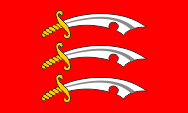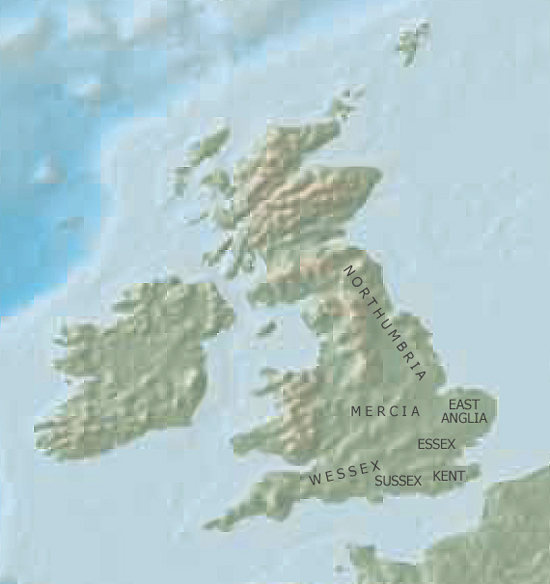mobile View, to the German Version tap the flag


- "Eastern Saxony"
- former Kingdom in Southern England
- historic County of England
- own name: Ēastseaxe
• Introduction
• History
• Flag
• Meaning/Origin of the Flag
• Map
Britannia was conquered by Roman legions around the year 43 and became in 85 a province of the Roman Empire. Towards the end of the fourth century the Roman Empire came under considerable pressure from outside, so that Britannia could no longer be held. Thus the Romans began to withdraw about 400 or 410. Shortly afterwards, Jutes and Angles began to migrate in eastern and southern Britannia coming from today's Denmark and Saxons coming from the area of the Weser and Elbe estuaries, and also some Frisians. The differences between the peoples blurred over the generations, and they were summarized under the term Anglo-Saxons. As fighters they have been very welcome for the mostly Romanesque Celtic British, against the since the withdraw of the Romans advancing Picts and Scots. Already in the middle of the fifth century, they had established themselves as the new aristocracy and began to separate from themselves by the formation of their own kingdoms.
Since the beginning of the 6th century, seven great kings have been known which dominated the south and east of Britannia. A formation of states that has become known in history as "Heptarchy" (Greek: hepta = seven). These have been the kingdoms of Sussex, Wessex, Essex, Kent, East Anglia, Mercia and Northumbria. However, in reality, there have been more and some smaller kingdoms, which, however, often existed for only a short time. In 825 Wessex, Sussex, Kent and Mercia became united under King Egbert of Wessex. Essex, East Anglia and parts of Mercia were occupied by invading Danes in the year 865 and became summarized as "Danelaw" (Danelag, territory of Danish law). In 1016 the Danish Knut the Great (brother of the king of Denmark) forced his election to the first king of England. After riots the Danish rule ended in 1050, and in 1066 Harald II., Earl of Wessex, was crowned to the first Anglo-Saxon King of England.
Source: Wikipedia (D)

The Kingdom of Essex was first mentioned in 527. It is a foundation of the Saxons, and was placed in the east of the area, which was inhabited by the Saxons in Britain. The name implies "Eastern Saxony". In the beginning it was under the supremacy of the Kingdom of Kent, from which it was possible to free itself at the beginning of the 7th century, however, it fell under the influence of East Anglia, and then under Mercia, in the middle of the 7th century. At the end of the 7th century, they took over the rule in Kent. At the beginning of the 8th century large parts of the country and also the capital London got lost to the Kingdom of Mercia. However, Mercia was defeated in the Battle of Ellandun by Wessex in 825, so that Essex became as a viceroyalty under the rule of Wessex and it was completely annexed by Wessex in 858. Shortly thereafter the Danes invaded and Essex came to the Danelaw. From 890 started the reconquest by King Alfred of Wessex and Essex became in this way a county of England.
Source: Wikipedia (D)


Flag of Essex,
ratio = 3:5,
Source, by: Wikipedia (EN)






The time of the Heptarchy belongs – in the themes of flags or coats of arms – to the period of protoheraldics. This means that seals, coats of arms or flags, as we know them today, were not yet in use. Nevertheless, it seems that there was a kind of symbolism, which is partly handed down, or it is known from the field of legends. The coats of arms or flags were designed in the modern age, which are used now for the ancient kingdoms of the Heptarchy.
The heraldry of Essex, which is known today, is historically handed down and shows three Saxon swords. This typical weapon of the Saxons was called "Seax" and supposedly the name of the tribe goes back to this weapon. However, a Seax was actually a straight, short weapon and not a crooked sword.
Source: Wikipedia (EN), Volker Preuß


Source: Freeware, University of Texas Libraries, modyfied by: Volker Preuß


![]()






